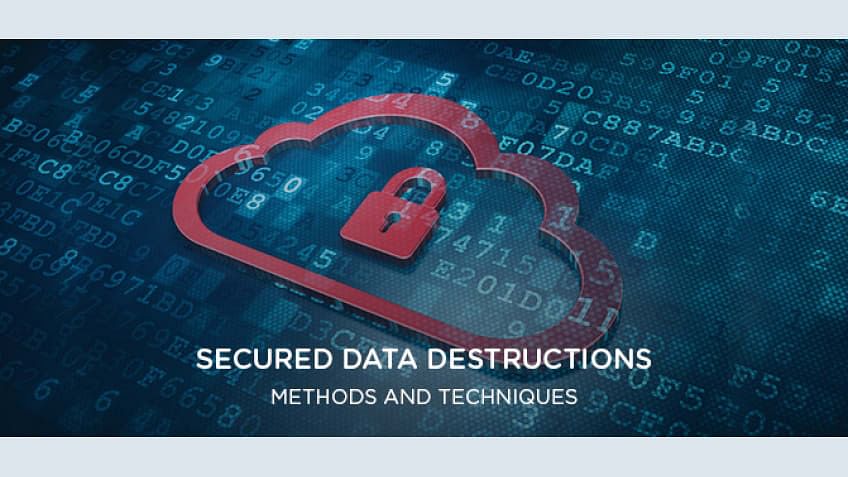How to Incorporate Data Destruction Techniques into Your Cyber Security Approach
How to Incorporate Data Destruction Techniques into Your Cyber Security Approach
Blog Article
Checking Out the Value of Data Destruction in the Context of Computer Safety And Security Services and Protecting Confidential Data
In an era where data breaches are progressively typical, the importance of efficient data destruction can not be overemphasized. Organizations needs to adopt rigorous measures to ensure that sensitive info is not just secured during its lifecycle however likewise decisively removed when no much longer necessary. The approaches utilized for information eradication, paired with compliance to lawful criteria, play a pivotal function in keeping confidentiality and trust fund. However, the implications of these techniques extend past mere compliance, influencing a business's online reputation and operational stability in the digital marketplace. What methods can companies execute to enhance their information devastation procedures?
Recognizing Information Destruction
Data devastation is an important component of computer protection that entails the long-term removal of data from storage gadgets to avoid unauthorized access and prospective data breaches. In a progressively digital landscape, organizations encounter increased risks connected with delicate information being incorrectly accessed or made use of. Reliable data devastation safeguards against these hazards, making certain that private dataâEUR" such as client info, intellectual home, and monetary recordsâEUR" can not be recuperated after disposal.
Understanding the relevance of information damage extends past plain conformity with regulative and legal frameworks; it is vital for keeping business stability and depend on. When data is poorly taken care of or inadequately damaged, the effects can be severe, including monetary loss, reputational damage, and legal liabilities.

Methods of Information Obliteration

One prevalent technique is information wiping, which entails overwriting existing information with arbitrary patterns numerous times. This strategy renders the initial information irretrievable, making it a preferred option for organizations seeking to protect private info.
One more method is degaussing, which uses a powerful electromagnetic field to disrupt the magnetic domain names on storage devices, properly erasing the data. This strategy is particularly efficient for magnetic media but is not relevant to solid-state drives.
Physical devastation is an additional robust approach, including the shredding or squashing of storage devices. This technique assurances that information recovery is essentially difficult, making it excellent for highly sensitive info.
Last but not least, file encryption can function as a complementary technique to information elimination. By securing information before removal, organizations can add an additional layer of safety and security, ensuring that even if remnants are recovered, they remain hard to reach without the decryption trick. Each approach should be picked based upon the degree of information level of sensitivity and the certain security needs of the company.
Legal Compliance and Information Protection
Organizations should navigate an intricate landscape of legal demands associated with information safety and security, particularly after carrying out approaches of data obliteration. Numerous regulations, such as the General Information Security Regulation (GDPR) and the Medical Insurance Mobility and Responsibility Act (HIPAA), impose strict standards on how companies must get rid of and take care of of sensitive information. Failing to adhere to these policies can lead to significant lawful repercussions, consisting of substantial penalties and reputational damages.
Data destruction processes must be diligently recorded to show conformity with appropriate legislations and criteria. This documentation not only functions as evidence of adherence to lawful obligations however additionally shows a commitment to guarding delicate information. Organizations should likewise develop clear policies regarding information retention and damage timelines, making certain that information is not held longer than necessary.

In addition, routine audits and evaluations of data devastation practices are vital to maintain compliance and adapt to progressing legal frameworks (data destruction). By proactively dealing with lawful needs, organizations can alleviate risks related to information breaches and demonstrate their commitment to look what i found data security. Ultimately, prioritizing legal compliance in data devastation processes is not just a regulative obligation, but a fundamental facet of a robust data security technique
Influence On Organization Credibility
The track record of a company can be significantly affected by its technique to information damage and monitoring. In today's electronic landscape, where data breaches can happen anytime, the failing to appropriately deal with sensitive details can result in serious consequences. Organizations that improperly take care of information destruction risk subjecting private customer information, which not just violates privacy laws yet likewise wears down trust fund among stakeholders and customers.
A ruined online reputation can result in decreased consumer loyalty, as clients end up being hesitant to engage with a service that has actually demonstrated neglect in securing their information. Unfavorable attention surrounding a data violation can have a long-term effect, as potential customers may be discouraged by the viewed absence of safety. This can cause a straight decline in earnings and market share.
Furthermore, services that focus on information damage as part of their protection approach can improve their track record by showcasing their commitment to protecting delicate info. By adopting stringent data monitoring practices, organizations can not just reduce dangers however additionally position themselves as trustworthy entities in their particular sectors, consequently reinforcing their general brand photo.

Finest Practices for Secure Disposal
Executing best methods for safe and secure disposal of information is essential for mitigating risks connected with information breaches and guaranteeing conformity with privacy regulations. Organizations needs to take on an extensive information disposal plan that outlines treatments for both physical and electronic information destruction.
For physical information storage space useful content devices, such as disk drives, shredding or degaussing is recommended to stop information recovery. In addition, organizations need to preserve a chain of wardship paperwork throughout the disposal procedure, ensuring accountability and traceability of disposed items.
For digital information, using software application that adheres to industry requirements for information wiping is vital. This software application must overwrite existing data several times, making recuperation basically impossible. It is additionally crucial to verify the effectiveness of the information damage procedure through audits or third-party assessments.
Educating workers on safe and secure disposal techniques includes another layer of safety, as human mistake can typically result in information exposure. Routinely updating and evaluating disposal plans guarantees positioning with progressing laws and technical improvements. By applying these ideal practices, organizations can dramatically minimize the danger of unapproved data accessibility and improve their general information protection technique.
Verdict
Finally, information damage is a basic facet of computer security solutions that ensures the defense of private info from unapproved access. Executing efficient approaches of information obliteration, adhering to legal compliance, and identifying the influence on company online reputation are crucial parts of a thorough information protection technique. By embracing best techniques for safe disposal, companies can foster count on with clients and secure delicate information, ultimately adding to an extra safe electronic landscape.
In an era where data violations are significantly usual, the significance of reliable information destruction can not be overemphasized.Data damage is a critical component of computer safety and security that includes the irreversible elimination of information from storage gadgets to prevent unauthorized gain access to and possible information violations. Organizations must additionally develop clear policies relating to information retention and damage timelines, ensuring that data is not held longer than essential.
By proactively resolving lawful requirements, companies can mitigate risks linked with information breaches and show their commitment to data security important source (data destruction). Eventually, prioritizing lawful conformity in data destruction processes is not simply a regulative responsibility, however a basic aspect of a durable information safety approach
Report this page